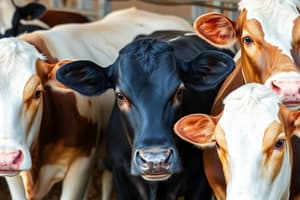Podcast
Questions and Answers
Which country is not among the top five milk-producing countries in Africa?
Which country is not among the top five milk-producing countries in Africa?
- Sudan
- Egypt
- South Africa
- Kenya
- Ghana (correct)
What percentage of Ethiopia's gross value of ruminant livestock production does the dairy sector contribute to?
What percentage of Ethiopia's gross value of ruminant livestock production does the dairy sector contribute to?
- 85%
- 63% (correct)
- 8%
- 83%
What is the main reason for milk processing being more important in the dairy industry than in other agricultural sectors?
What is the main reason for milk processing being more important in the dairy industry than in other agricultural sectors?
- Milk is more abundant
- Milk is more perishable (correct)
- Milk is more nutritious
- Milk is more expensive
Flashcards are hidden until you start studying
Study Notes
Introduction to Dairy Cattle Production and its Role in the Global and Ethiopian Economy
- Dairy cattle production is the act of raising cattle for milk production, with cows being the primary source of milk.
- Milk is a valuable commodity, with world milk production estimated at 748.7 million tons in 2011, and cow’s milk accounting for 620.7 million tons.
- In 2010, the value of milk represented 8.9% of the value of all agricultural products globally.
- Africa's cow milk production in 2004 was only one-fifth of the world average yield, with Sudan, Egypt, Kenya, South Africa, and Algeria being the top five milk-producing countries.
- Ethiopia has one of the largest livestock inventories in Africa, with 83% of milk coming from cattle, and the sector contributing 63% to the gross value of ruminant livestock production.
- Ethiopia produces approximately 3.2 billion liters of milk from 10 million milking cows, with households consuming 85%, 8% processed into products with longer shelf-life, and 7% sold.
- Milk production is labor-intensive and provides employment opportunities, making it a crucial cash crop for smallholders.
- The dairy industry has four unique features: milk is bulky and highly perishable, strict quality regulations are required, small-scale producers dominate the industry, and milk processing is more important than in other agricultural sectors.
- The history of dairy development in Ethiopia can be divided into three phases: the Imperial Regime (1950-74), the Socialist Regime (1974-91), and the Liberalization Phase (1991-present).
- During the Imperial Regime, the modern dairy industry began to develop, with the government introducing high-yielding dairy cattle and establishing milk processing and marketing facilities.
- During the Socialist Regime, the government shifted its attention to rural producers and established the Dairy Development Enterprise to operate nationalized state farms, establish a milk collection network, and provide advisory and technical services to farmers.
- During the Liberalization Phase, the government focused on privatization, liberalization, and deregulation, and the dairy industry became more market-oriented, with the private sector playing a more prominent role.
Studying That Suits You
Use AI to generate personalized quizzes and flashcards to suit your learning preferences.





